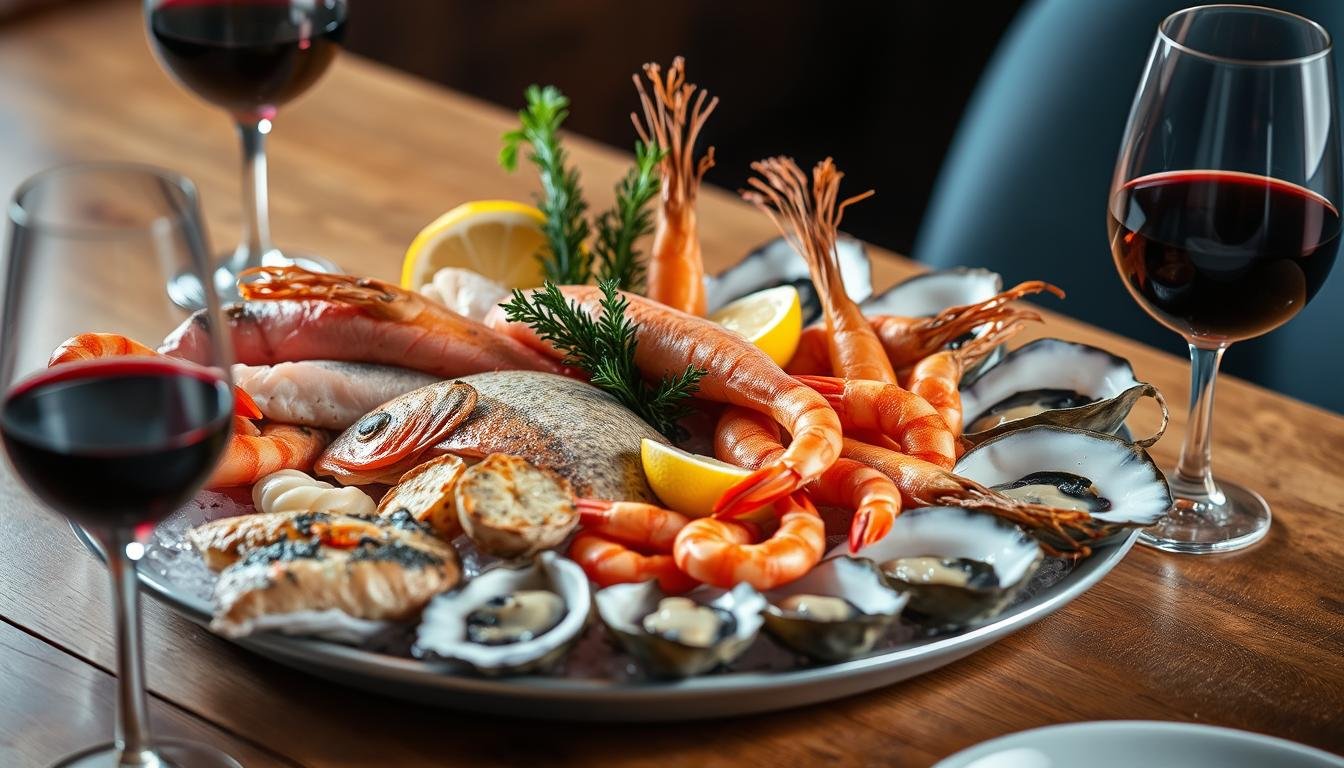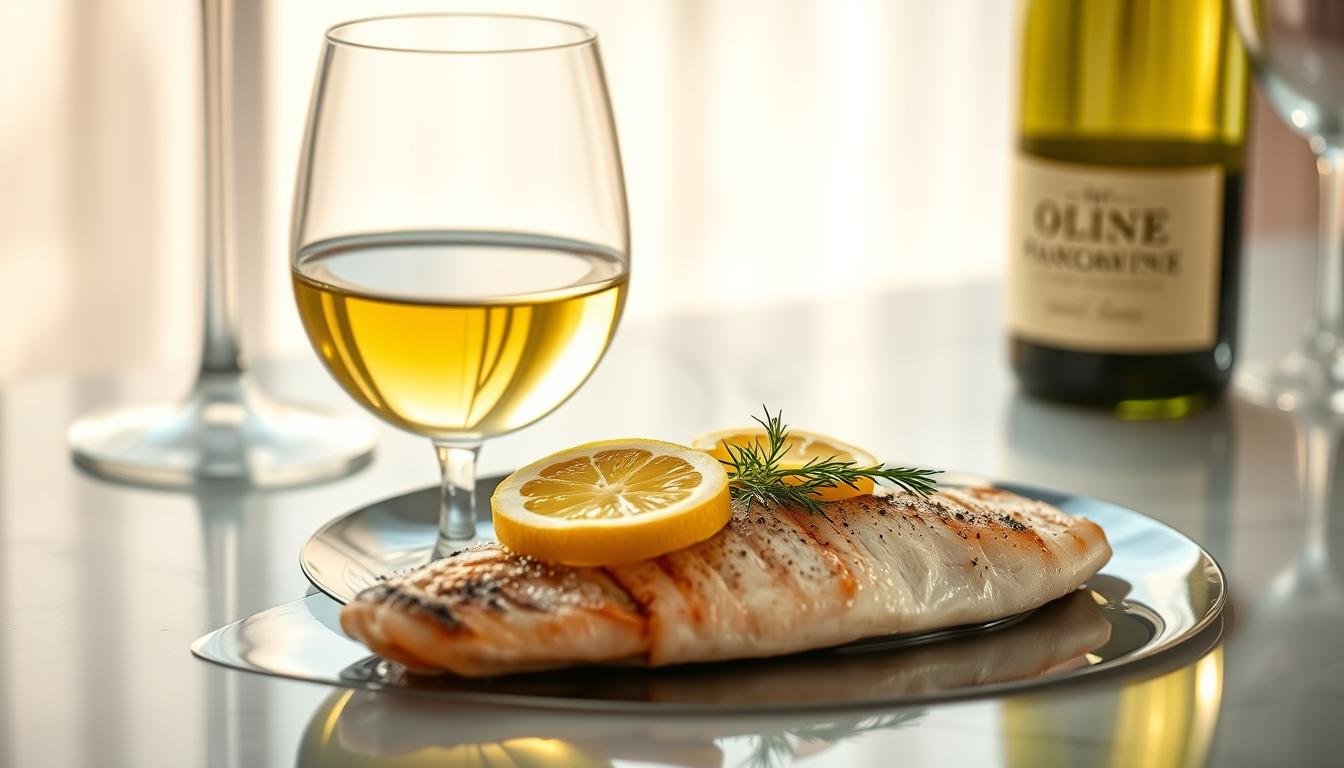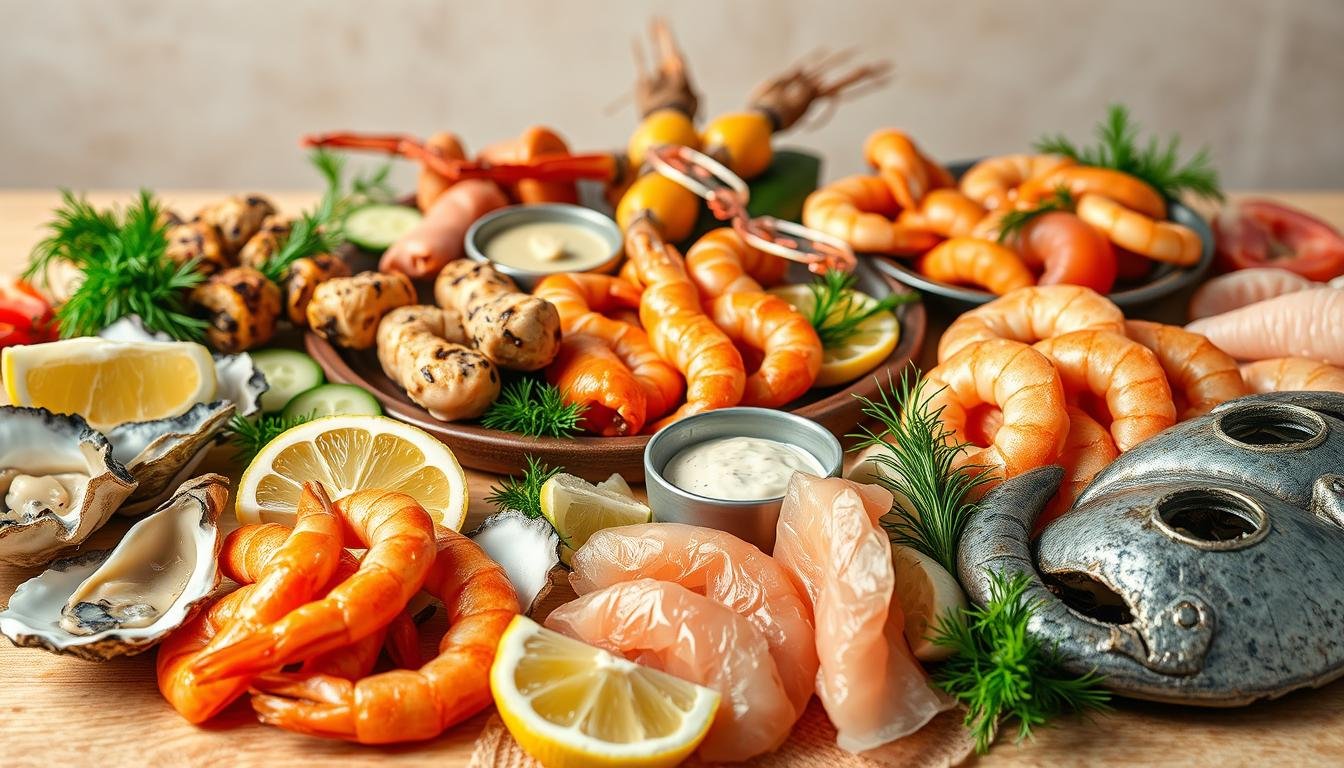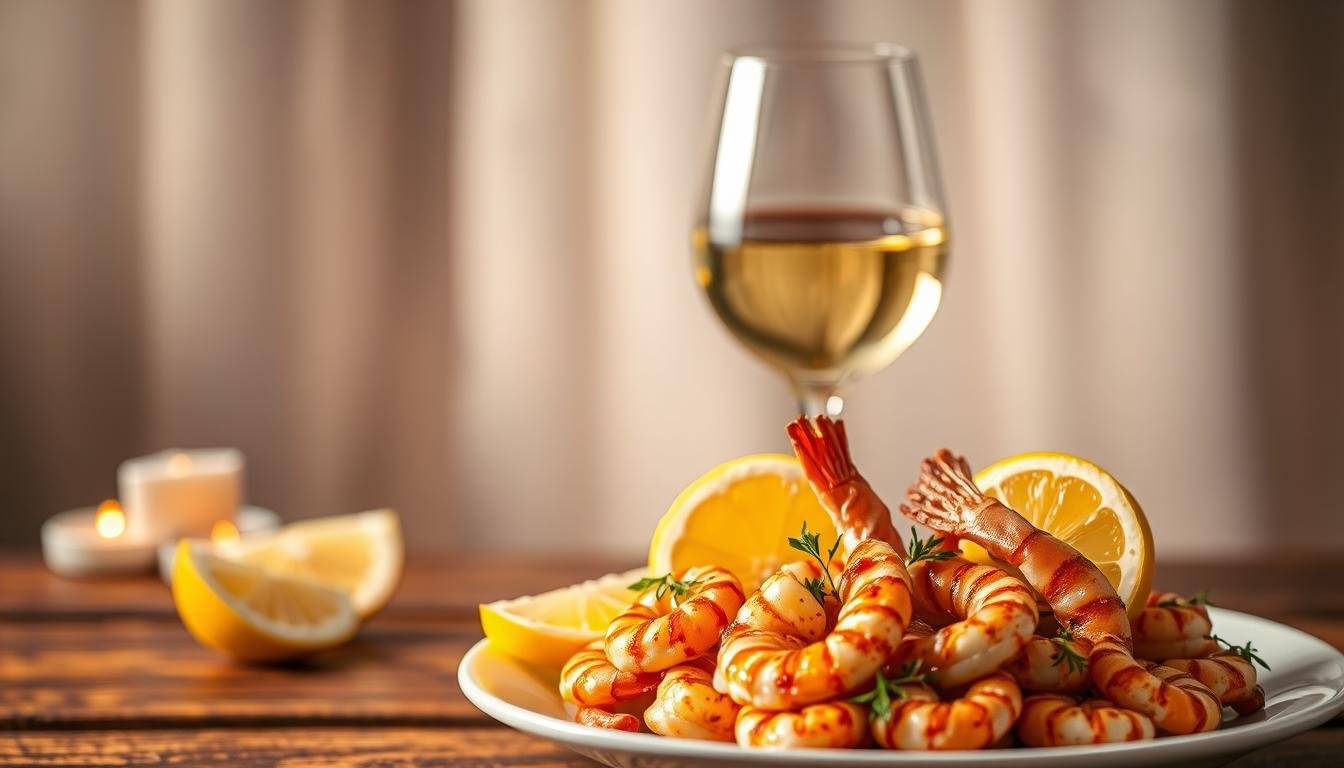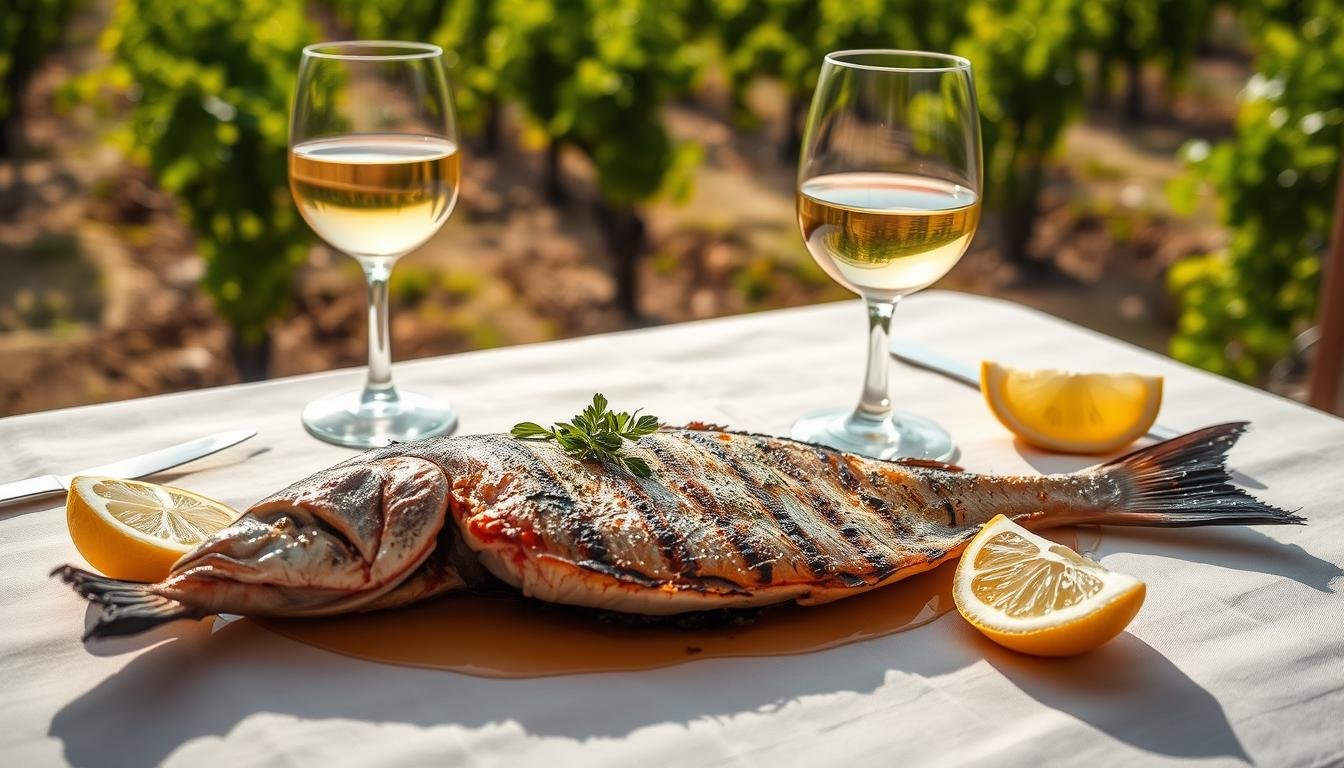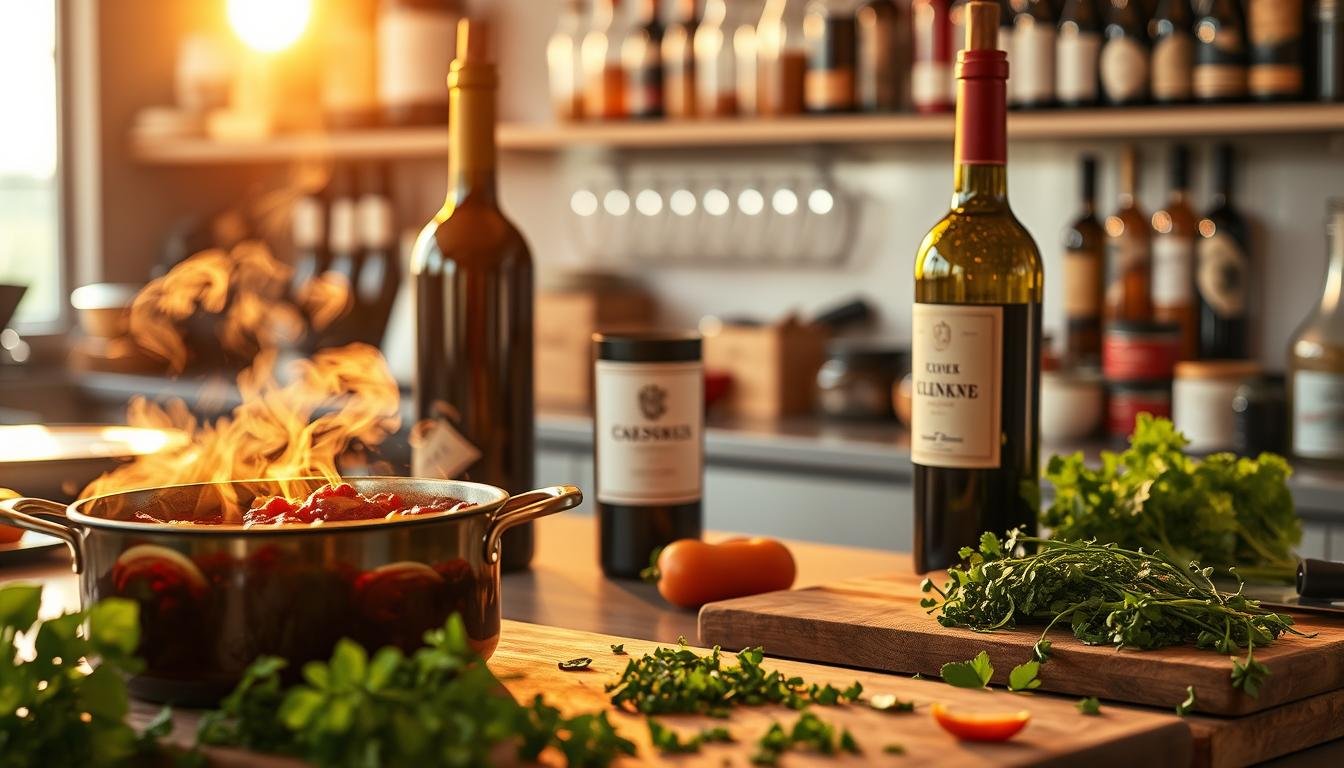Pairing wine with seafood often means choosing white wine. But, red wines offer a new frontier. They can make your meal even more exciting. Whether it’s salmon or mackerel, the right red wine can make it taste better.
Don’t stick to the usual choices. Try Pinot Noir or Grenache for something new. Finding the perfect match means understanding flavors, textures, and more. It’s a journey for anyone who loves food and wine.
For seafood platters, a chilled Sauvignon Blanc is great. It pairs well with oysters and clams. But, a Pinot Noir can be perfect for richer fish like salmon. This guide will help you pick the best wine for your seafood. For more tips, check out our guide on pairing wines with salmon.
Key Takeaways
- Red wine can enhance the flavors of various types of seafood, offering a fresh alternative to traditional white wine pairings.
- A deeper understanding of flavor profiles, textures, and cultural contexts can help you choose the best wines for seafood.
- Red wines like Pinot Noir and Grenache are excellent choices, particularly for richer fish such as salmon.
- Pairing wine with seafood involves experimentation and a willingness to venture beyond conventional norms.
- Achieving the ideal temperature is crucial for both wine and seafood, enhancing the overall dining experience.
Understanding the Basics of Wine Pairing
Wine pairing is a key part of cooking. It’s about picking a wine that goes well with your food. This makes your meal better and more enjoyable.
What Is Wine Pairing?
Wine pairing is about finding a wine that goes well with your food. You look at things like flavor, texture, and acidity. For example, light wines like Pinot Grigio are great with seafood like fish and scallops.
Importance of Flavor Profiles
Flavor profiles are very important in wine pairing. Richer wines, like oaked Chardonnay, go well with richer seafood like lobster. Wines with high acidity, like Sauvignon Blanc, balance out the richness of seafood.
Common Misconceptions About Pairing
Many people think only white wines go with seafood. But red wines, full-bodied rosé, and light reds like Pinot Noir can also be great. Trying different wines can lead to new and exciting pairings. Also, Mediterranean seafood dishes pair well with white wines from Italy and Greece, like Pinot Grigio and Vermentino.
Why Choose Red Wine with Fish?
Choosing red wine with fish might seem odd at first. But it brings unique benefits that make seafood meals better. Adding red wine to your seafood and wine pairing guide can be a delightful surprise.
Flavor Enhancement
Red wine can really boost the taste of fish, especially bold ones like salmon and tuna. Its complex flavors add depth to your dishes. This makes for a memorable dining experience.
Exploring Different Textures
Wine and fish textures can create exciting pairings. For example, a light-bodied Pinot Noir pairs well with smoked sablefish. It balances its rich oil and soft texture, offering a luxurious feel.
Cultural Contexts in Pairing
Cultural traditions influence how we pair food and wine. In the Mediterranean, red wines often go with seafood. This shows red wine’s versatility and adds to your seafood meal.
Types of Red Wines to Consider
Choosing the right red wine can make your seafood meal better. Knowing about different red wines helps you pick the best one for your seafood. Let’s look at some top red wines for seafood.
Light-bodied Red Wines
Light-bodied red wines, like Pinot Noir, are great for seafood. They have mild tannins and high acidity. This makes them perfect for milder fish, like pan-seared trout.
Pinot Noir is especially good for seafood. It complements the delicate flavors without being too strong.
Medium-bodied Red Wines
Medium-bodied red wines, such as Merlot, are also good for seafood. They have a balance of fruitiness and acidity. This makes them great for heartier fish, like tuna and swordfish.
Grenache, found in GSM blends, adds a lot of fruitiness. It’s perfect for spiced fish dishes.
| Wine Type | Characteristics | Suggested Pairing |
|---|---|---|
| Pinot Noir | Light-bodied, mild tannins (12-13%) | Pan-seared trout |
| Merlot | Medium-bodied, 13-14% alcohol | Tuna, Swordfish |
| Grenache | 40% fruitiness in blends | Spiced fish dishes |
Full-bodied Red Wines
For bold seafood dishes, full-bodied red wines like Cabernet Sauvignon are good. They have a strong taste and high tannin levels. They can be a unique choice if you like to try new things.
Your taste preferences are key in wine pairing. For more tips on pairing wines with dishes, check out this guide. For insights on the importance of wine pairings, visit this link.
Key Fish Varieties for Red Wine Pairing
Choosing the right red wine for fish depends on the type of fish or seafood you’re serving. The wrong wine can ruin your meal, but the right one can make it unforgettable. This section explores the best fish for red wine pairings and suggests wines for each.
Salmon: The Red Wine Champion
Salmon pairs well with light to medium-bodied red wines. Its rich texture and fat content support wines with bright fruit flavors, like Pinot Noir. George Miliotes recommends Oregon Pinot Noir and classic Napa Valley Chardonnay for salmon. Alsace Pinot Gris also works well, adding depth without overpowering the fish.
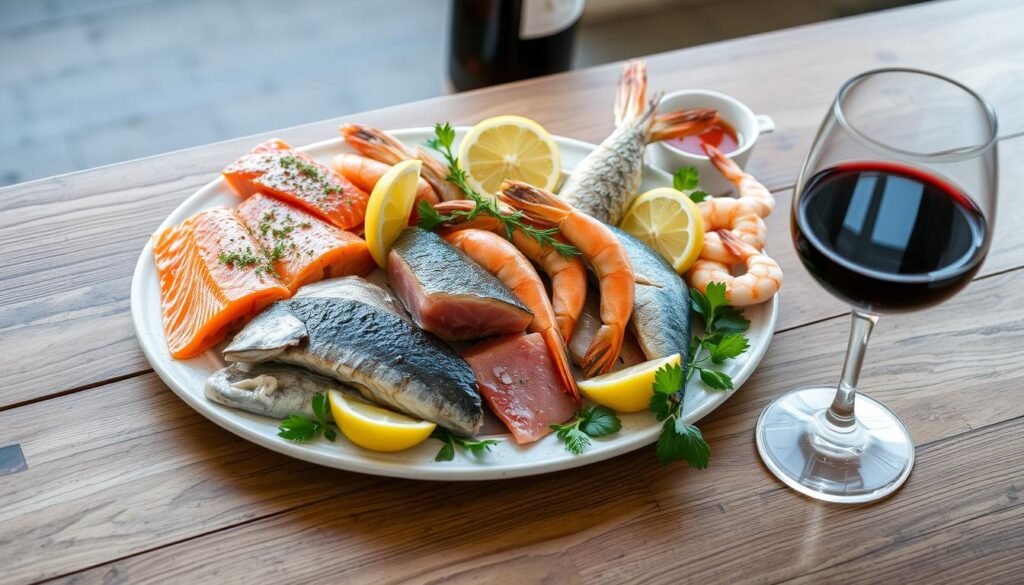
Tuna: Bold and Rich
Tuna’s meaty texture and bold flavor call for stronger reds. Light-bodied reds like Pinot Noir are good, but Syrah or Merlot offer a bolder choice. Carlin Karr advises against new oak aged wines and tannic ones to avoid a fishy taste. A balanced wine with good acidity complements tuna well.
Mackerel: A Savory Option
Mackerel’s savory and oily taste needs a wine that’s slightly sweet or fruity. Beaujolais or fruit-forward Grenache are great choices. Niels Sluiman stresses the importance of balancing flavors between food and wine. Choose reds with refined tannins for the best pairing with mackerel.
These seafood wine recommendations show how the right wine can elevate your meal. By understanding each fish’s unique characteristics, you can make pairings that please your taste buds and impress your guests.
The Role of Cooking Methods
The way you cook your seafood can change what wine goes best with it. Knowing how cooking methods affect flavors helps pick the best wines for seafood, including red wines for seafood.
Grilling and Roasting
Grilling or roasting fish gives it a smoky, bold taste. This calls for wines with strong flavors. Smoky reds like Merlot or Syrah pair well with grilled or roasted fish. They match the charred and rich tastes of the dish.
Baking vs. Searing
Baking and searing add subtle flavors, unlike grilling or roasting. For these, choose refined reds like Pinot Noir. This wine complements the fish’s mild and delicate texture without overpowering it. Plus, picking a wine you like, like a quality Pinot Noir, makes the meal better.
Smoking Fish for Flavor
Smoking fish brings out deep, intense flavors. These need a wine with strong character to match. A robust red wine for seafood, like a full-bodied Malbec, balances the smoky notes, creating a perfect pairing.
For more tips on picking the right wine for cooking, check out this guide by Bonterra Wines. It offers great advice on choosing wines that enhance your dishes, highlighting the role of cooking methods in seafood and wine pairing.
Flavor Profiles: Matching Fish with Red Wine
Finding the perfect match between fish and red wine is an art. It requires understanding the key elements of both. This guide helps you make smart choices by looking at acidity, tannin levels, and spices and seasonings.
Acidity in Fish and Wine
Acidity is key for a good pairing. For example, salmon’s oily taste goes well with a Chardonnay Reserve’s bright acidity. A Pinot Noir with moderate acidity also works well with fish like tuna or salmon. It’s important to match the acidity of the seafood with the wine for a balanced taste.
Tannin Levels to Consider
Tannins can greatly affect your pairing. Choose red wines with low to moderate tannins for fish. Pinot Noir’s gentle tannins are great with tuna or crab cakes. Stay away from wines with high tannins, as they can overpower seafood’s delicate flavors.
Spices and Seasonings
Spices and seasonings in seafood dishes are crucial for wine pairing. For spicy dishes, a Gewürztraminer can balance the heat with its sweetness. An off-dry Riesling is also good with spicy shrimp, offering a mix of sweetness and acidity. A Chardonnay Reserve is perfect for richer shellfish with creamy sauces, enhancing their flavor.
| Fish | Recommended Wine | Reason |
|---|---|---|
| Salmon | Chardonnay Reserve, Pinot Noir | Moderate acidity and tannins enhance rich textures. |
| Shellfish (e.g., lobster, shrimp) | Blanc de Noir, Chardonnay Reserve | Red berry flavors and minerality complements rich textures. |
| Tuna Steaks | Rosé, Pinot Noir | Pairs well with grilled or seared tuna, enhancing umami flavors. |
| Spicy Seafood Dishes | Gewürztraminer, Off-dry Riesling | Balances heat with sweetness and acidity. |
| Delicate White Fish (e.g., cod, sea bass) | Pinot Gris, Sauvignon Blanc | Bright acidity and fruit flavors enhance delicate textures. |
Wine and Fish Pairing Tips
Pairing wine with fish is an exciting culinary adventure. From bright white wines to strong reds, finding the right match can make your meal better. Here are some key tips to help you.
Don’t Fear the Bold Flavors
Choosing bold wines can really bring out the flavors in seafood. While white wines are common, don’t be afraid to try light reds like Pinot Noir with salmon or tuna. Full-bodied wines like White Burgundy or Oaked Chardonnay are great with lobster and scallops.
Trust Your Palate
Your taste is key when picking wines for seafood. What you like is more important than what’s traditional. A Sauvignon Blanc might pair well with halibut, but you might prefer a dry Riesling or zesty Pinot Grigio. Trust your taste.
Experimentation is Key
Trying different wine and fish pairings can lead to new favorites. You might enjoy a Pinot Noir with smoked sablefish or a fruity Rosé with smoked salmon. This way, you can discover new and exciting flavors.
For more tips on pairing wine with seafood, check out this guide.
Improving your seafood with the right wine is an art. For detailed advice, look at this beginner’s guide.
Serving Temperature and Glassware
Knowing the right serving temperature and glassware can make your wine and fish pairing better. Whether you’re trying red wines with seafood or matching fish with your favorite wine, these details matter a lot.
Optimal Temperature for Red Wine
Red wine’s flavor is best when served at the right temperature. It should be between 55 and 65°F (13-18°C). For seafood, lighter reds are best at 50-55°F (10-13°C), which brings out their delicate scents without overpowering the fish.
Medium-bodied reds are best at 55-60°F (13-16°C), showing off their balanced taste. Full-bodied reds, at 60-65°F (16-18°C), bring out the rich flavors needed for heartier seafood.
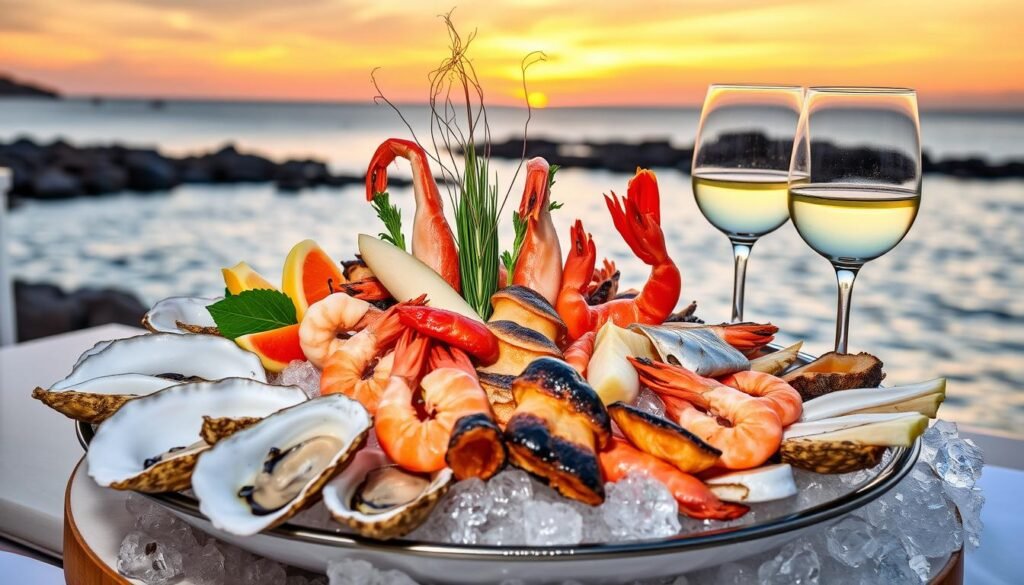
Choosing the Right Glass
The right glass can change how you taste wine. For red wines with seafood, a standard red wine glass is best. It lets the wine breathe, enhancing its flavors and scents. Hold the glass by the rim for lighter reds to keep them cool.
For heavier reds, use a broader, shorter goblet. This focuses their fruity aromas.
Serving Techniques for Fish
Properly serving fish can make it taste better with red wines. Grilling or lightly searing fish adds smoky and savory notes that match red wine’s tannins. Using fresh herbs, citrus, and light seasonings keeps the fish’s natural flavors in the spotlight, pairing well with many red wines.
Learn more about wine serving techniques and their impact on your dining experience in this guide to enjoying wine.
“Wine makes every meal an occasion, every table more elegant, every day more civilized.” – André Simon
Here’s a table with La Crema wines and their ideal serving temperatures:
| Wine | Serving Temperature |
|---|---|
| Pinot Gris | 45°F (7°C) |
| Chardonnay | 50°F (10°C) |
| Marsanne-Roussanne | 50°F (10°C) |
| Pinot Noir | 55-60°F (13-16°C) |
| Cabernet Sauvignon | 60°F (16°C) |
| Rosé | 50°F (10°C) |
| Sparkling Wine | 45-50°F (7-10°C) |
Food & Wine Pairing Events
Exploring the best wines for seafood is fun and educational. Food and wine pairing events can help you learn and enjoy these pairings. Here are some ways to dive into the world of seafood and wine.
Hosting a Tasting at Home
Hosting a wine tasting at home is a great way to try different pairings. You can invite family and friends to taste various wines with seafood. For example, Chablis pairs well with seafood ceviche, and Champagne goes great with lobster.
This hands-on experience lets you find your favorite pairings. It’s both fun and educational.
Restaurant Pairing Experiences
Many restaurants offer special wine pairing menus. These menus can introduce you to expertly paired meals. You might try Pinot Noir with grilled salmon or Albariño with shellfish.
These experiences can broaden your understanding of wine and seafood. You’ll see how different wines can enhance seafood dishes.
Local Wine and Fish Festivals
Local wine and fish festivals offer a wide range of seafood and wine pairings. These events feature many vendors and tasting booths. You can try various wines and seafood dishes.
These festivals often highlight the growing popularity of Albariño for seafood pairings. They’re great for community engagement and discovering local favorites.
| Wine | Seafood Pairing |
|---|---|
| Champagne | Oysters, Seafood Tempura, Fried Fish |
| Chablis | Scallops, Seafood Ceviche |
| Pinot Grigio | Whitefish, Sole, Perch, Tilapia |
| Albariño | Tuna, Salmon, Shellfish |
Going to these events can really improve your pairing knowledge. Whether at home, in a restaurant, or at a festival, these experiences help you create your own guide. Enjoy trying new combinations and finding your favorites!
Common Pairing Mistakes to Avoid
Exploring top wine pairings for seafood means avoiding common mistakes. These errors can ruin your meal. Knowing what to avoid helps your wine and seafood dishes go together perfectly.
Overlooking Personal Preferences
Not thinking about your taste is a big mistake. Traditional pairings are good, but your taste should come first. Choose wines you like. For more on this, check out Your Guide to Wine and Food Pairings in France.
Sticking to Old Rules
Many stick to old pairing rules, missing new and tasty options. For example, bold wines like Cabernet Sauvignon can go well with seafood. Light reds like Pinot Noir also pair well with fatty fish like salmon.
Ignoring Quality of Ingredients
Good ingredients make a big difference. Use top-quality seafood and wines. Wines with high acidity, like Sauvignon Blanc, can bring out seafood flavors. For more pairing tips, see this article on wine and seafood.
Avoid these mistakes for a better dining experience. You’ll find the perfect wine for your seafood, making every meal special.
The Impact of Region on Pairing
Understanding regional influences can greatly improve your seafood wine pairings. Wines from different places have unique traits, especially with red wines for seafood. It’s key to pick the right one. This part explains how region affects wine and seafood pairings.
Old World vs. New World Wines
Old World wines come from places like France, Italy, and Spain. They are known for being subtle and having high acidity. This makes them perfect for seafood.
New World wines, from countries like the U.S., Australia, and Chile, are bold and fruity. They offer a nice contrast to fatty seafood.
Regional Fish and Wine Pairings
In Europe, pairing local wines with dishes is a tradition. For example, Chablis from Burgundy goes well with oysters from Brittany. This is because of the region’s rocky coast and the wine’s crispness.
Loire Valley Chenin Blanc also pairs well with French seafood. This shows how local wines can enhance the taste of seafood.
Matching Local Favorites
Choosing local favorites makes dining more authentic and flavorful. For instance, a Sauvignon Blanc from New Zealand pairs well with ceviche. Its acidity brings out the dish’s flavors.
A structured Chardonnay complements creamy Alfredo. This shows how the right wine can enhance a dish’s richness. For more pairing ideas, check out this guide on wine with seafood and.
| Wine Type | Regional Example | Seafood Pairing |
|---|---|---|
| Crisp White Wines | Sauvignon Blanc (New Zealand) | Ceviche, Grilled Shrimps |
| Rosé Wines | Provence Rosé (France) | Tuna Poke Bowl, Shrimp Tacos |
| Sparkling Wines | Champagne (France) | Oysters, Clams |
| Light Red Wines | Pinot Noir (Oregon) | Smoked Seafood |
| Full-bodied White Wines | Chardonnay (California) | Steamed Lobster, Creamy Pasta |
Conclusion: Embrace the Experimentation
Exploring wine pairings with seafood is a thrilling adventure. While many prefer white wines, reds can also be perfect matches. The secret to finding great pairings is to be open to trying new things.
Learning about different grape varieties is key. For example, Viognier pairs well with shellfish, and Pinot Noir complements salmon. This knowledge helps you find the perfect match for your taste.
Find Your Unique Pairings
Pairing wine with seafood is all about personal taste. You might love Sauvignon Blanc with oysters or Viognier with lobster. It’s all about trying different things and seeing what you like.
Don’t be afraid to try unusual combinations. A Sangiovese with Mediterranean seafood might surprise you with its delicious flavors.
Encourage Sharing and Feedback
Sharing your wine pairing adventures with others makes it more fun. Talking about the flavors and textures you discover can be enlightening. It’s a chance to learn together and find new favorites.
Ask your friends and family for their favorite pairings. Their suggestions might lead you to try something amazing.
The Joy of Discovering New Matches
The best part of pairing wine with seafood is finding new, exciting matches. Sauvignon Blanc’s crispness is perfect with light fish dishes. A light-bodied red can enhance the taste of grilled fish.
Embrace the excitement of trying new things. Finding your perfect pairing is a journey filled with joy and discovery.

